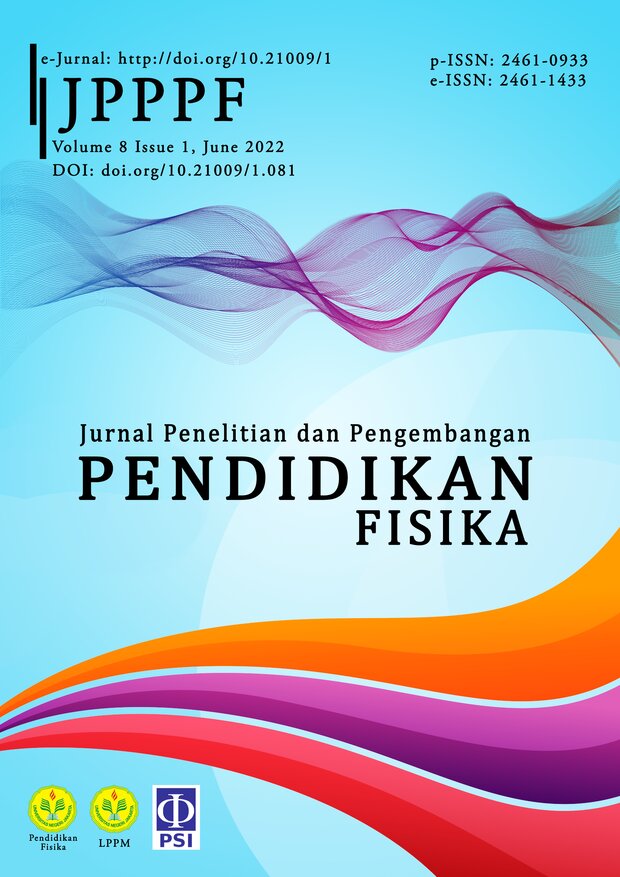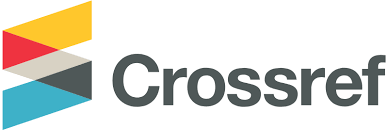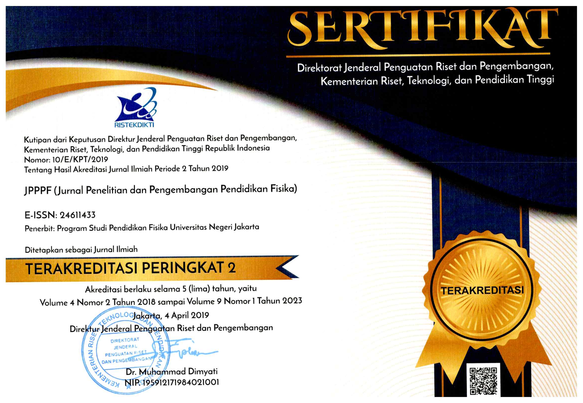Understanding the Newton’s Motion Concept Through Qualitative and Quantitative Teaching
Abstract
This research aims to analyze the influence of qualitative teaching and quantitative pursuit on understanding the concept of motion Newton Student of Science Education Study Program of FMIPA UNM. The main objectives of this study were to obtain information: 1) the characteristics of pretest and post-test results of understanding of Newton’s motion concepts of students following qualitative teaching, 2) characteristics of pretest and post-test results of understanding of Newton’s motion concepts of students following quantitative teaching, 3) student activities, and 4) a significant difference understanding of Newton’s motion concepts of students who follow qualitative teaching and who follow quantitative teaching. The research method used is mixed. The embedded experimental model, the population of 100 student’s odd semester of 2019/2020 divided into group A of 50 students and group B of as many as 50 students. The techniques used for data collection were interviews and tests, and the data were analyzed qualitatively and quantitatively. The results of the study were found in group A: 1) initial understanding of Newton’s concept based on Aristotelian’s theory of 30 students (60 percent), Impetus 15 students (30 percent), and Newton’s five students (10 percent). The post-test result of understanding Newton’s concept of motion is based on the theory of Aristotle for one student (2 percent), impetus’s theory for four students (8 percent), and Newton’s theory for 45 students (90 percent). In group B: 2) early understanding of Newton’s motion concept based on Aristotelian theory for 35 students (70 percent), Impetus theory for ten students (20 percent), and Newton’s theory for five students (10 percent). The post-test result of understanding Newton’s concept of motion based on the theory of Aristotle for five students (10 percent), Impetus theory for 35 students (70 percent), and Newton’s theory for ten students (20 percent); 3) student activity in following learning included in the high category, and 4) There is a significant difference understanding of Newton motion concept of students who follow qualitative teaching and who follow quantitative teaching. The study found that strict mathematical formulations do not foster the ability to comprehend the physical concept qualitatively. Students are generally only interested in solving physics problems that are manipulating numbers and equations. They are not passionate about the qualitative aspects of mathematical formulations.
References
Aristotle, A 1984, ‘Metaphysics’, Princeton University Press, New Jersey.
Cataloglu, E & Ates, S 2014, ‘The Effects of Cognitive Styles on Naïve Impetus Theory Application Degrees of Pre-Service Science Teachers’, International Journal of Science and Mathematics Education, vol. 12, pp. 699-719.
Chang, W, Bell, B & Jones, A 2014, ‘Historical development of Newton’s laws of motion and suggestions for teaching content’, Asia-Pacific Forum on Science Learning and Teaching, vol. 15, no. 1, p. 1.
Chen, HT 2006, ‘A Theory-Driven Evaluation Perspective on Mixed Methods Research’, Research in The Schools, vol. 13, no. 1, pp. 75-83.
Dittrich, T 2014, ‘The concept of information in physics: an interdisciplinary topical lecture’, European Journal of Physics, vol. 36, no. 1, pp. 1-38.
Drisko, JW 2016, ‘Teaching Qualitative Research: Key content, course structures, and recommendations’, Qualitative Social Work, vol. 15, no. 3, pp. 307-321.
Erfan, M & Ratu, T 2018, ‘Analysis of student difficulties in understanding the concept of newton’s law of motion’, JIPF: Jurnal Ilmu Pendidikan Fisika, vol. 3, no. 1, pp. 1-4.
Frels, RK, Onwuegbuzie, AJ, Leech, NL & Collins, KMT 2014, ‘Pedagogical Strategies Used by Selected Leading Mixed Methodologists in Mixed Research Courses’, The Journal of Effective Teaching an online Journal Devoted to Teaching Excellence, vol. 14, no. 1.
Ghislandi, P, Raffaghelli, J, Sangra, A & Ritelle, G 2020, ‘The street lamp paradox: Analysing students’ evaluation of teaching through qualitative and quantitative approaches’, Journal of Educational, Cultural and Psychological Studies (ECPS), vol. 21, pp. 65-85.
Gile, D 2017, ‘Interpretation Research: A New Impetus?’, HERMES - Journal of Language and Communication in Business, vol. 8, no. 14, pp. 15-31.
Halim, A, Soewarno, S, Elmi, E, Zainuddin, Z, Huda, I & Irwandi, I 2020, ‘The impact of the e-learning modele on remediation of misconceptions in modern phyiscs course’, Jurnal Penelitian & Pengembangan Pendidikan Fisika, vol. 6, no. 2, pp. 203-216.
Halloun, I & Hestenes, D 1985, ‘Common Sense Concepts About Motion’, American Journal of Physics, vol. 53, pp. 1056-1065.
Johnson, DR 2011, ‘A Quantitative Study of Teacher Perceptions of Professional Learning Communities’ Context, Process and Content’, thesis, Seton Hall University.
Khiari, C 2011, ‘Newton’s laws of motion revisited: some epistemological and didactic problems’, Latin-American Journal of Physics Education, vol. 5, p. 2.
Khiari, CE 2011, ‘Newton’s Laws Of Motion Revisited: Some Epistemological And Didactic Problems’, Latin-American Journal of Physics Education, vol. 5, no. 1, p. 2.
Kilburn, D, Nind, M & Wiles, R 2014, ‘Learning as Researchers and Teachers: The Development of a Pedagogical Culture for Social Science Research Methods?’, British Journal of Educational Studies, vol. 62, no. 2, pp. 191-207.
McCloskey, M, Washburn, A & Felch, L 1983, ‘Intuitive Physics’, Scientific American, pp. 114-130.
Negoro, RA & Karina, V 2019, ‘Development of a four-tier diagnostic test for misconception of oscillation and waves’, Jurnal Penelitian & Pengembangan Pendidikan Fisika, vol. 5, no. 2, pp. 69-76.
Olesiak, J 2015, ‘Nature and Necessity in Aristotele’s Physics’, Studia Phylosophie Cristianae, vol. 51, no. 1, pp. 55-73.
Papachristou, CS 2014, ‘Aristotle’s Theory of ‘Sleep and Dreams’ in the light of Modern and Contemporary Experimental Research’, Electronic Journal For Philosophy, vol. 21, no. 1.
Poutot, G & Blandin, B 2015, ‘Exploration of Students’ Misconceptions in Mechanics using the FCI’, American Journal of Educational Research, vol. 3, no. 2, pp. 116-120.
Quintaneiro, A 2015, ‘Against the Aristotelian Method Concerning Scientific Knowledge’, Undergraduate Philosophy Journal, Athene Noctua, no. 3.
Said, MA, Arsyad, M & Tawil, M 2021, ‘The development of electronic practicum modules at electronic course for physics education program’, Jurnal Penelitian & Pengembangan Pendidikan Fisika, vol. 7, no. 2, pp. 99-106.
Syamsidar, S, Khaeruddin, K & Helmi, H 2021, ‘The effectiveness of using student worksheets to practice science process skills on hooke’s law material’, Jurnal Penelitian & Pengembangan Pendidikan Fisika, vol. 7, no. 1, pp. 83-90.
Tawil, M 2013a, ‘Portfolio-based Physics Learning Model To Improve Critical Thinking Skills’, International Journal of Education and Research, vol. 1, no. 9.
Tawil, M 2013b, ‘Pembelajaran Berbasis Simulasi Komputer Untuk Meningkatkan Keterampilan Berpikir Kreatif’, Jurnal Ilmu Pendidikan (JIP), vol. 17, no. 3.
Tawil, M 2015, ‘Penerapan Pembelajaran Guided Inquery Terhadap Hasil Belajar Calon Guru IPA Pada Mata Kuliah Interaksi Antara Faktor-faktor Fisik’, Jurnal Sains dan Pendidikan Fisika, vol. 11, no. 2.
Tawil, M 2017, ’Developing Students’ Creativity through Computer Simulation Based Learning in Quantum Physics Learning’, International Journal Of Environmental & Science Education, vol. 12, no. 8, pp. 1829-1845.
Trudel, L, Metioui, A & Arbez, G 2020, ‘Design of a teaching-learning sequence to facilitate transition between qualitative and quantitative reasoning about kinematics phenomena’, TOJSAT: The Online Journal of Science and Technologi, vol. 10, no. 3, pp. 85-134.
Zhou, G, Xu, J & Martinovic, D 2017, ‘Developing pre-service teachers’ capacity in teaching science with technology through microteaching lesson study approach’, Eurasia: Journal of Mathematics Science and Technology Education, vol. 13, no. 1, pp. 85-103.
Copyright (c) 2022 Muh. Tawil, Muhammad Amin Said

This work is licensed under a Creative Commons Attribution 4.0 International License.











